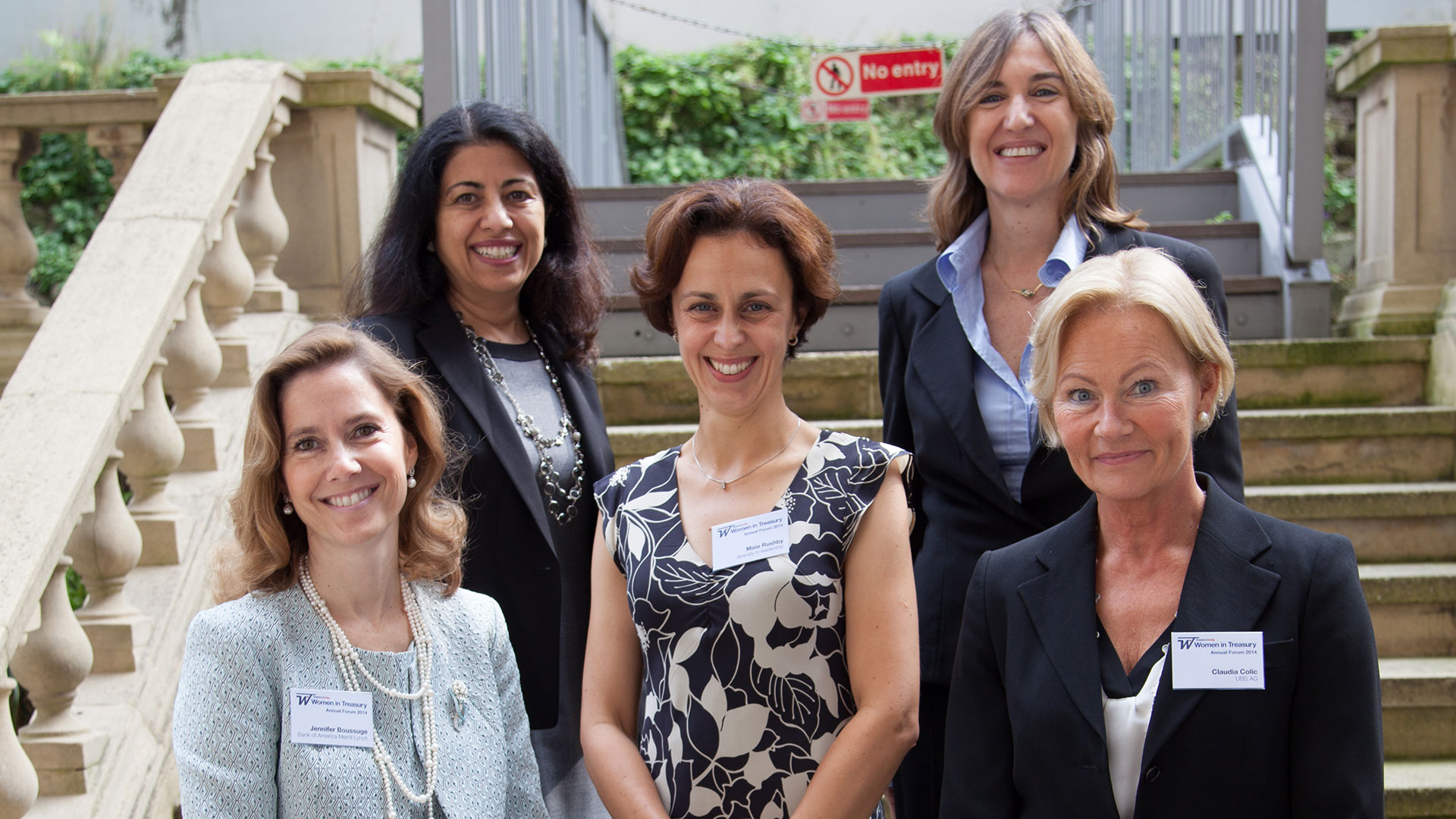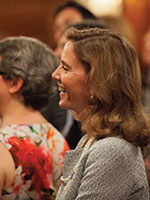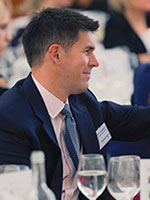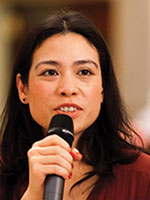
Treasury Today’s recent Women in Treasury Forum in London was certainly a colourful event. Stern opinions, bold personalities (and some fantastic fashion sense) saw traditional treasury stereotypes pushed to their limit.
In the world of corporate treasury, being in a room with 185 female colleagues and just five male peers is a rather unique sensation. But challenging the norm is precisely what Treasury Today’s Women in Treasury initiative is all about – and for those 190 attendees, the second annual Women in Treasury Forum that took place in London on 18th September certainly delivered.
Although conversations during the pre-lunch networking session were already sparking much debate, Angela Berry, Publisher of Treasury Today and Founder of the Women in Treasury initiative, prompted further dialogue by sharing some of the findings of this year’s Women in Treasury Study, proudly supported by RBS. One of the most surprising highlights – judging from the audible gasps in the room – was the fact that 4% of respondents (all female) believed that they were being paid more in their current role than their male counterparts. Somewhat predictably though, the number of women that felt the reverse, was still very high at 48%, the Study showed.
Another contentious statistic was that, despite so many women having family responsibilities, 56% do not have flexible working arrangements. In the 25-34 age range, this figure increases to a significant 72%. So it’s clear that achieving an effective work life balance still remains tough for many professionals – both female and male. And it’s no coincidence that this topic was the first to be addressed by the lively panel session, facilitated by Maia Rushby of diversity in leadership, which took place after lunch.
A tricky balancing act
Treasury Today’s Woman of the Year – Anita Prasad, General Manager, Treasury Capital Management, Microsoft – was the perfect person to pick up this subject and share her experience and knowledge with the audience. According to Anita, the secret to achieving a balance between her work life and her home life is to not forcibly separate the two. “Work is part of my life, just like my family is, my friends are and my hobbies are. Rather than trying to juggle my work and my home life, I prefer them to be intertwined – my work is key to defining who I am. That’s why it is so important to find a job that you have a passion for so you can feel professionally fulfilled. If you can do that, it won’t even seem like work,” said Anita, prefacing that observation with the disclaimer that it might not be everyone’s ideal solution.
For some, it might seem like having such a close connection between your work and family life would mean that work would always intrude, but Anita believes in leveraging technology and setting clear expectations with her partners and stakeholders to define her optimal balance. “My team knows that I am always reachable except for the two hours starting at 5.30am three times a week; it is my gym time. It is equally important to balance needs of your team and business deliverables and make exceptions if needed. This is when the ability to leverage my smartphone, tablet and data that is always available in the cloud is a great enabler,” she explained.

“Similarly, my husband respects the fact that the first thing I do in the morning is to check my emails on my phone. Once I’m up-to-speed with work, it’s easier for me to focus on the family – because I’m not thinking about what might be going on at work in the back of my mind,” she admitted. You need to live in the moment and be fully devoted to work (or family) while you are at work (or vacationing with family); don’t feel guilty about spending time on either aspect of your life.
In addition to setting clear boundaries, “I have a set of clear principles that guide me in everything I do: honesty, integrity and trust,” Anita told the audience. These principles have helped her throughout her career to maintain the work/life relationship that she has so successfully mastered.
Battle of the sexes
The next panellist to speak was Jennifer Boussuge, Head of Global Transaction Services, EMEA, Bank of America Merrill Lynch, who tackled the topic of driving equality. Like Anita, Jennifer wakes up every day with her BlackBerry in her hand – but she too has a very understanding husband who, Jennifer explained, actually put his career on hold in order to allow her to progress.
“I’m extremely lucky because, throughout my career, I’ve been given the support that I need both at home and in the workplace. Many women don’t have that luxury and they struggle to reach their full potential in the workplace as a result,” noted Jennifer. “That’s a real shame, because the statistics around the value that women in senior positions bring to a company are quite something. A McKinsey study, across all industry sectors, found that the companies with the highest proportion of women on their boards significantly, and consistently, outperformed those with no female representation by 41% in terms of return on equity, and by 56% in terms of operating results. The numbers speak for themselves.”

So what is holding women back? “What women require to be successful isn’t always the same as what men need to be successful,” Jennifer observed. “We need to carefully consider the level of coaching and mentoring that we are providing for women – not only on returning from maternity leave, but throughout their careers. Women often aren’t as vocal as men in the workplace, and managers need to recognise that. Just because women don’t voice their desire for promotion, doesn’t mean that they don’t want the opportunity.”
As well as improving the formal networks, it is also important for women to take it upon themselves to do more informal networking, she explained. “Men play golf or go to the pub on Thursday nights for a drink. Creating these kind of networks for women, while also ensuring they have key sponsors and mentors from within the organisation, are vital to encourage greater diversity at senior levels.”
The dream team
Sonia De Paolis, Treasury Director at TomTom – and the next panellist to speak – agreed with Jennifer’s observations, saying: “We work in a male-dominated environment and we need to create the space for women to proceed. As such, it is important to have self-awareness about what you want to do and where you want to go; don’t just do what is expected.”
On the subject of nurturing talent, Sonia had some useful, practical advice for attendees: “When you look for talent, the most important thing is to put your biases to one side.” She went on to explain that there are sometimes hidden gems – people that might not necessarily tick all the boxes on paper, but in reality have a lot to offer. “As an example, there was a young lady who was in an administrative role in another department in our company, who volunteered to get involved in a cross-functional project at a time when no-one from that department was being overly co-operative. She was absolutely brilliant when we collaborated, so much so that we invited her to join our team and gave her the opportunity to study for her qualifications as well. She jumped at the chance and she was enormously motivated by the recognition of her abilities.”
Not only is it important to nurture hidden talents, but the whole team should be given something to believe in – a vision and a mission, Sonia added. “Creating a work environment where people feel that they are really part of something is invaluable. People work hard for what they believe in.”
Climbing the ladder
Building a dream team is also a very important step in helping you to get further ahead in your career, according to the final panellist, Claudia Colic, Head of Transaction Banking, UBS AG, Switzerland. “You need to have the confidence to hire the best team possible – don’t be afraid to hire people that are better than you at certain aspects of the job and don’t be afraid to be challenged by your team,” she advised.

Other key steps in moving up the career ladder, said Claudia, are: understanding who you are and recognising where your strengths, weaknesses and interests lie. “Once you know what you want and what your interests are, then you can match them with your strengths – not that they are always complementary. Then, you can begin to cultivate a recognisable identity for yourself, rather like a personal brand, so that everyone knows what you stand for.” To really get ahead, this brand also needs to be authentic, Claudia noted. “Generally speaking, women aren’t good at pretending to be something they’re not.”
Finally, Claudia advised attendees to work on communicating with confidence if they want to get ahead in their career. “Because of our collaborative nature, women often like to ask others their opinion, so that everyone has a chance to voice their thoughts. Although this is in many ways good for the team, it can make it seem like you don’t have a firm opinion of your own. That’s not what people look for in a leader – they want someone who knows their own mind.”
Securing success
After the panel’s individual presentations, there was a lively question and answer session that covered everything from part-time working to the relative productivity of women returning from maternity leave – which interestingly, the panel felt was actually greater, since new mothers are more motivated to get everything done in order to leave the office at a decent hour!
Some additional networking then took place over coffee before the event closed. This was a good opportunity to gather some feedback on the Forum from attendees and to find out what advice they would be taking away from the event. Karen Van den Driessche, EMEA Treasury Director, AVNET, said: “Anita is the perfect fit for the Woman of the Year Award, she totally deserves it. I particularly enjoyed her comments about managing your work/life balance effectively, and that if you are passionate about something then it shouldn’t be seen as work.”
Francesca Mosca, Director, Client Coverage at ING was impressed by the 360 degree approach to the topic of Women in Treasury. “There really was advice for everyone from the panel, whether it be how to learn from your mistakes, or how to leverage informal as well as formal networks in order to get ahead. Another key takeaway for me was the panel’s advice around building a brand for yourself. It’s important to match your strengths with your interests and skills, so that you can be confident in what you do.
On the topic of work/life balance, the point around distinguishing between a job and a career seemed to strike a real chord with the audience. A job is a nine to five, but a career will always be part of your life. To be successful in your career, there will naturally be risks that need to be taken and compromises that need to be made,” she said.
Helen Robbins, Senior Manager, Institutional Client Propositions, HSBC Global Asset Management agreed that the stories from the panel were very inspiring. “I liked the point that even senior women still need a mentor. And that it’s ok to ask someone to be your mentor – women should have the confidence to do this. It is also important to understand how others have overcome issues in the workplace and you don’t often get that opportunity outside of events such as this. The Women in Treasury Forum is a vital platform for networking and knowledge-sharing,” she observed.
The mentoring discussion was also very interesting for Claudia Ehler, European Treasury Manager at SPX Corporation. “I haven’t had a mentor for many years and I’ve been inspired by the panel’s comments to go and look for a mentor. I’ve also learned that it’s ok to ask people that aren’t necessarily in your immediate work circle to mentor you – it could be someone that you admire in another company.”
Elsewhere, “getting together with peers and having a forum focused on women makes the discussion more open and frank as we have similar challenges to manage,” commented Claudia. This sentiment was shared by many others in the audience, who greatly appreciated the focus of the event, but would also like to see more men at next year’s event so that they can hear first-hand about the challenges that women face in the world of treasury. Consider the gauntlet well and truly thrown down.
